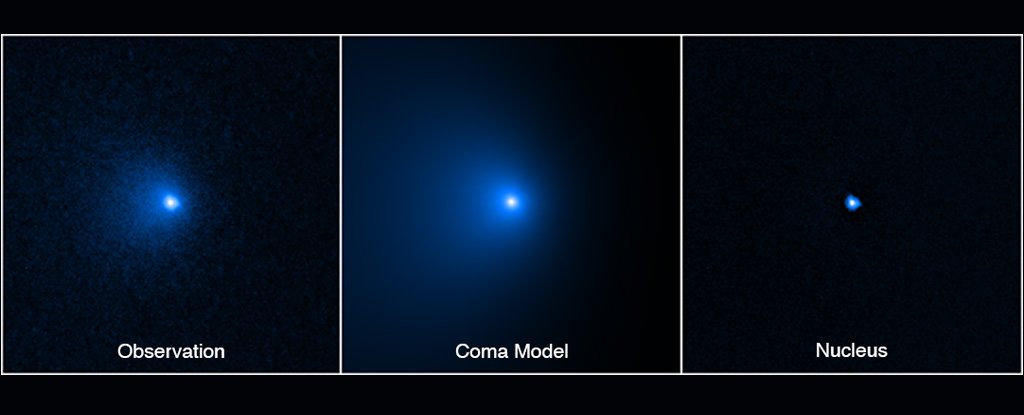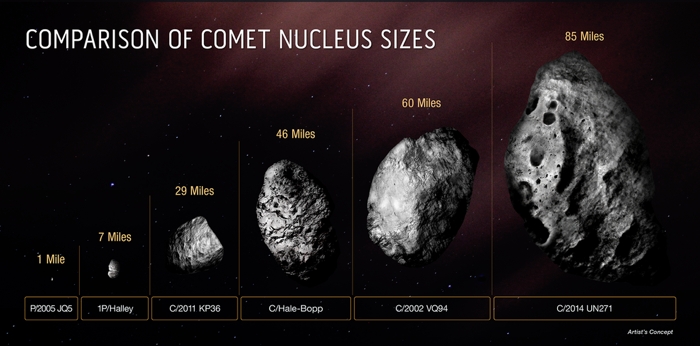The biggest comet at any point found has been going towards the Sun for north of 1 million years, and its immense scope focuses a light on the puzzling articles that make up probably the greatest construction in our Solar System.

Credits: NASA
In another review, cosmologists utilized the Hubble Space Telescope to affirm that the strong focus of the goliath comet C/2014 UN271 (Bernardinelli-Bernstein) is the biggest comet core at any point recognized. It estimates a stunning multiple times bigger than most known comets, at very nearly 140 kilometers wide (around 85 miles).
Nonetheless, that shockingly huge size – or rather the obvious strangeness of it – could express more about us and our restricted origination of comets than it does about anything more.
C/2014 UN271 hails from the Oort Cloud: a tremendous, circular dispersing of cold articles proposed to encompass the Sun at the most profound and most far off stretches of our Solar System (up until this point away, truth be told, it’s remembered to reach out at minimum a fourth of the way towards the following closest star framework, Alpha Centauri).
Sounds quite enormous, correct? It is, hypothetically talking. Nonetheless, the Oort Cloud is up to this point away thus hard to recognize, it’s fundamentally a tremendous speculative secret, despite the fact that stargazers believe it to be perhaps the biggest design in our Solar System.
On occasion, however, something arises out of this cryptic mass, gravitationally baited towards the Sun from the distance of the astronomical hinterlands.

C/2014 UN271 is one such item, and it stands to educate us much concerning the presence of the frozen ‘unblemished’ masses that make up the Oort Cloud. These are remembered to have shaped right off the bat in the internal Solar System, prior to being flung out to its furthest edges by the gravitational impacts of monster planets like Jupiter and Saturn.
“This comet is in a real sense a hint of something larger for a huge number of comets that are too weak to even consider finding in the more far off pieces of the Solar System,” says space expert David Jewitt from UCLA.
“We’ve generally thought this comet must be huge in light of the fact that it is so splendid at such an enormous distance. Presently we affirm it is.”
In the new investigation, Jewitt and individual scientists, drove by first creator Man-To Hui from the Macau University of Science and Technology, determined the size of C/2014 UN271 in the most elevated goal yet. They based upon past evaluations by utilizing Hubble perceptions and displaying to detach the core from the comet’s unconsciousness – the long tail of ice sublimating into gasses in the comet’s wake.
“We affirm that C/2014 UN271 is the biggest significant stretch comet at any point distinguished,” the group writes in their new paper.
“”
(NASA/ESA/Man-To Hui, Macau University of Science and Technology/David Jewitt, UCLA/Alyssa Pagan, STScI)
Above: Sequence showing a Hubble picture of the comet, its displayed trance state, and the detached core.
The disclosure of C/2014 UN271 was declared last year, after it was observed concealed in a collection of observational information caught by the Dark Energy Survey somewhere in the range of 2014 and 2018. Resulting follow-up examinations uncovered C/2014 UN271 was really gotten as soon as 2010.
However even that early impression doesn’t start to incorporate the fantastic length of the comet’s excursion. It follows a roughly 3-million-drawn out curved circle around the Sun, the state of which implies it has been gradually moving toward the Sun for essentially north of 1 million years.
It is because of arrive at its nearest way to deal with the Sun – known as perihelion – in 2031, so, all in all Bernardinelli-Bernstein will in any case stay around 1 billion miles from the Sun, prior to arcing back outwards on its ovoid direction.
Yet again that implies we have right around a time of working on observational open doors in front of us, to become familiar with C/2014 UN271 and its kind as the comet moves nearer, before it sneaks off unobtrusively into the dim.
The discoveries are accounted for in The Astrophysical Journal Letters.
Here is a record document:
Significant stretch comets are viewed as compositionally probably the most flawless extras from the early planetary group. For the greater part of their lifetime, they have been put away in the low-temperature climate of the Oort cloud, at the edge of the planetary group (Oort 1950). Late years saw IDs of a few extensive stretch comets dynamic at ultralarge heliocentric distances (rH ≳ 20 au), suggesting that the extensive stretch comets might be more thermally handled than recently suspected (Jewitt et al. 2017, 2021; Meech et al. 2017; Hui et al. 2018, 2019; Bernardinelli et al. 2021). Dissimilar to most comets that are just dynamic inside the circle of Jupiter (rH ≲ 5 au), driven by sublimation of water ice (e.g., Whipple 1950), the reason for movement in far off comets stays hazy. Potential clarifications for trans-Jovian action incorporate sublimation of supervolatiles like CO and CO2 (e.g., Womack et al. 2017), crystallization of nebulous ice (e.g., 1P/Halley; Prialnik and Bar-Nun 1992), and warm memory from prior perihelion entry (e.g., Comet Hale-Bopp; Szabó et al. 2008). Before we can utilize remotely dynamic comets to straightforwardly explore the development states of the early nearby planet group, it is of incredible logical significance to comprehend how their action unfurls at extraordinary heliocentric distances.
The new disclosure of C/2014 UN271 (Bernardinelli-Bernstein) offers us one more astounding an open door to concentrate on a comet a long way from the Sun. This extensive stretch comet was found in Dark Energy Survey (DES) information at an astounding inbound heliocentric distance of rH ≈ 29 au, with extra prediscovery perceptions from >30 au from the Sun and showing an undeniable cometary element at rH ≳ 20 au (Bernardinelli et al. 2021; Farnham et al. 2021; Kokotanekova et al. 2021). As indicated by the orbital arrangement by JPL Horizons, the current barycentric circle of C/2014 UN271 is profoundly circular (unusualness e = 0.9993), with a high perihelion distance of q = 10.9 au and a semimajor pivot of $a=\left(1.57\pm 0.04\right)\times {10}^{4}$ au. The size and the albedo of the cometary core are much of the time the main actual boundaries among numerous others. As of late, Lellouch et al. (2022) detailed that the core of the comet, 137 ± 17 km in distance across, is the biggest among throughout the entire known period comets and has a visual mathematical albedo of pV = 0.049 ± 0.011. In this paper, we present our autonomous investigation of the core size and albedo of the comet in view of a perception at a heliocentric distance of ∼20 au, itemized in Section 2. We present our investigation in Section 3 and conversation in Section 4.
2. Perception
We got five back to back pictures, every one of 285 s length, in one visit of the comet under General Observer program 16886 utilizing the 2.4 m Hubble Space Telescope (HST) and the UVIS station of the Wide-Field Camera 3 (WFC3) on 2022 January 8. To accomplish the greatest awareness of the office, we took advantage of the F350LP channel, which has a pinnacle framework throughput of 29%, a powerful frequency of 585 nm, and a FWHM of 476 nm. For productivity, we read out just the UVIS2-2K2C-SUB gap, the 2047 × 2050 full quadrant subarray on the UVIS channel with a picture size of 0farcs04 pixel−1 covering a field of perspective on 81” × 81” across. The telescope followed the nonsidereal movement of the comet, bringing about followed foundation sources, in spite of the significant stretch of the comet. Picture vacillating was performed once between the third and fourth openings in order to alleviate likely effects from CCD antiquities. The it is summed up in Table 1 to notice math of the comet.
Table 1. Noticing Geometry of Comet C/2014 UN271 (Bernardinelli-Bernstein)
Date and Time (UT) a Filter ${t}_{\exp }$ (s) b rH (au) c δ (au) d α (°) e ε (°) f θ−⊙ (°) g θ−v (°) h ψ (°) I
2022 Jan 08 09:24-09:56 F350LP 285 19.446 19.612 2.8 78.8 66.5 334.3 2.8
Notes.
a Mid-openness age. b Individual openness time. c Heliocentric distance. d Comet-HST distance. e Phase point (Sun-comet-HST). f Solar stretching (Sun-HST-comet). g Position point of the projected antisolar course. h Position point of the extended negative heliocentric speed of the comet. I Orbital plane point (among HST and the orbital plane of the comet).
Download table as: ASCIITypeset picture
In the HST pictures, the comet has a distinct optocenter inside its brilliant quasicircular trance like state of ∼4” in breadth, with an expansive tail of ≳15” long coordinated roughly northeastwards (Figure 1).
Figure 1.
Zoom In Zoom Out Reset picture size
Figure 1. HST/WFC3 F350LP picture of comet C/2014 UN271 (Bernardinelli-Bernstein) middle consolidated from the five individual openings taken on 2022 January 8. The showed picture is scaled logarithmically and is situated with the end goal that the J2000 central north is up and east is left. Likewise checked are the bearings of the projected antisolar vector (−⊙) and the extended negative heliocentric speed of the comet (− v ). A scale bar of 5” long is shown.
Download figure:
Standard picture High-goal picture
3. Investigation
In this part, we present our photometry to oblige the core of comet C/2014 UN271 in light of our HST perception. Prior to completing any photometric examination, we eliminated inestimable beam hits and hot pixels with the Laplacian vast beam dismissal calculation L.A. Enormous by van Dokkum (2001) in IRAF (Tody 1986), which effectively delivered us with much cleaner pictures of the comet while its sign was left immaculate. We decided the picture zero-point and the related vulnerability in the V band utilizing sun oriented analogs with the WFC3 UVIS Imaging Exposure Time Calculator, 5 which completely covered the variety scope of significant stretch comets and their cores (Jewitt 2015, and references in that).
3.1. Direct Photometry
The presence of the splendid trance state (Figure 1) presents an impediment to the immediate estimation of the sign from the core. We utilized three strategies for expanding ability to disconnect the nu…
Read more here: https://iopscience.iop.org/article/10.3847/2041-8213/ac626a